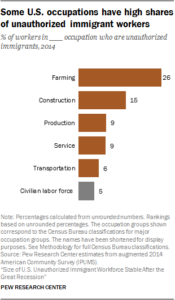Pew says there is no such thing as “jobs Americans will not do” – us too! Occupations of unauthorized immigrant workers (illegal aliens)
“U.S.-born workers accounted for a majority of workers in all major occupation groups…”
Pew Research Center
November 3, 2016
Occupations of unauthorized immigrant workers
BY JEFFREY S. PASSEL AND D’VERA COHN
Although unauthorized immigrants made up 5% of the nation’s civilian workforce in 2014, they accounted for a much higher share (26%) of the workers in farming occupations. Unauthorized immigrants also were 15% of workers in construction jobs in 2014. U.S.-born workers accounted for a majority of workers in all major occupation groups, including 54% of the farming workforce in 2014 and 73% of the construction workforce. Only in construction jobs and farming jobs do unauthorized immigrant workers outnumber lawful immigrant workers (15% vs. 12%, and 26% vs. 20%). (See the table here for data on workers’ status by major occupation.)
Unauthorized immigrants also were somewhat overrepresented in 2014 in production jobs, which include manufacturing, food processing and textile occupations, where they were 9% of the workforce. In 2014, unauthorized immigrants also held 9% of service jobs, a larger share than their 5% of the overall workforce.
However, unauthorized immigrants made up only 2% each of management, professional and office support workers. In those occupational categories, U.S.-born workers made up at least 85% of the jobholders.
As with industries, there are some very specific occupations with particularly high concentrations of unauthorized immigrant workers. The occupations tend to be subgroups of the major occupations with the highest shares of unauthorized immigrant workers. The occupations where at least one-quarter of workers are unauthorized immigrants include drywall installers (31% in 2014), miscellaneous agricultural workers (30%), roofers (29%), construction painters (26%) and brick masons (25%). U.S.-born workers, however, account for the largest share of workers in all these occupations. (See the table here for data on these and other specific occupations.)
Compared with U.S.-born workers, unauthorized immigrant workers are more likely to be employed in service and construction occupations. About a third of unauthorized immigrant workers (32% in 2014) are employed in service occupations, compared with 17% of U.S.-born workers who hold these types of jobs. Construction jobs employed 16% of unauthorized immigrant workers in 2014, triple the share of U.S.-born workers (5%) in those occupations. Production and maintenance jobs employed 14% of unauthorized immigrant workers in 2014, but 9% of U.S.-born workers. Only 4% of unauthorized immigrant workers held farming jobs in 2014, but about 1% of U.S.-born workers did.
Among unauthorized immigrant workers, 6% held management jobs in 2014, compared with 15% of U.S.-born workers who did. An additional 8% were in professional occupations, compared with 22% of U.S.-born workers. Sales and office support occupations employed 13% of unauthorized immigrant workers, compared with 25% of U.S.-born workers who held these types of jobs.
State occupation patterns
At the state level, farming is overwhelmingly the occupation where unauthorized immigrants make up the highest share of the workforce.4
It is the top occupation by this measure in 32 states. For the nation, unauthorized immigrant workers are overrepresented in farming jobs, where they made up 26% of workers in 2014 compared with the overall workforce, where they represented 5% of U.S. workers. Construction ranks first in nine states. Nationally, unauthorized immigrant workers held 15% of construction jobs in 2014.
However, when looked at from the perspective of the distribution of the unauthorized immigrant workforce, service occupations rank first in 37 states and the District of Columbia. Service occupations also dominate at the national level, employing 32% of the unauthorized immigrant workforce. (See tables here for the top occupations for unauthorized immigrants by state in 2014)…READ MORE HERE
Pagination



